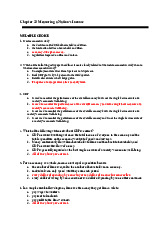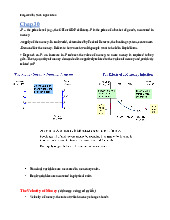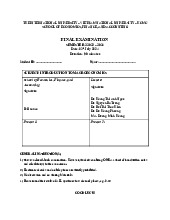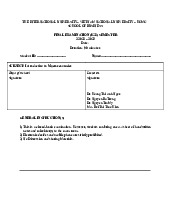











Preview text:
Midterm review for Introduction to Macroeconomics
1. What are the determinants of productivity? (2/2 Điểm )
a. Physical capital, Consumption, Investment, GDP.
b. Physical capital, Technology, Human capital, Natural resources.
c. Technology, Investment, Human capital, Natural resources.
d. Consumption, Investment, Government spending, Net exports.
2. The amount of goods and services produced from each hour of a worker's time is called (2/2 Điểm ) a. per capita GDP. b. per capita GNP.
c. the standard of production. d. productivity.
3.A nation's standard of living is determined by a. its productivity.
b. its gross domestic product. c. its national income.
d. how much it has relative to others.
4. Financial intermediaries are:
a. The same as financial markets.
b. financial institutions through which savers can indirectly provide funds to borrowers.
c. The markets that facilitate stock and bond transactions.
d. Financial institutions through which savers can directly provide funds to borrowers.
5. Barb, a homemaker who works as a volunteer, is counted as a. employed. b. unemployed. c. not in the labor force. d. Both b and c are correct.
6.The real interest rate is
a. The interest rate paid or charged by Đông Á Bank.
b. The interest rate corrected for the rate of inflation.
c. A high interest rate used by various firms to boost sales.D. All of the above. 7. Human capital is: a. technological knowledge.
b. the knowledge and skills that workers acquire through education, training, and experience.c.
land, rivers, and mineral deposits.
d. the stock of equipment and structures that is used to produce goods and services.
8.A few years ago, based on concepts similar to those used to estimate U.S. employment figures,
the Canadian adult noninstitutionalized population was 21.4 million, the labor force was 14
million, and the number of people employed was 12.4 million. According to these numbers, the
Canadian labor-force participation rate and unemployment rate were about
a. 81 percent and 7.5 percent.
b. 65 percent and 7.5 percent.
c. 65 percent and 11.4 percent. d. 58 percent and 13 percent.
9.Which of the goods and services produced in the economy are included as part of GDP? a. all goods and services
b. all final goods and services bought and sold in legal markets
c. all final goods and services which are bought and sold in markets
d. all final goods and services bought and sold in legal markets plus the imputed value of some other
legal goods and services that are not bought and sold in markets
10.M1 equals currency plus demand deposits plus a. Nothing else. b. Other checkable deposits.
c. Traveler’s checks plus other checkable deposits.
d. Traveler’s checks plus other checkable deposits plus savings deposits.
11.Suppose the cost of the basket in 2005 was $3,300, and the cost of the basket in the base year
was $3,000. Find the CPI for 2005. a. 10. b. 909. c. 110. d. 11.
12. If a textbook publishing company buys new U.S. computer equipment to increase worker productivity, (2/2 Điểm )
a. investment will be higher, but GDP will be unchanged, since the computers will replace workers.
b. neither investment nor GDP will be higher, since computers are not final goods.
c. investment will be higher, but GDP will be higher only if workers are, indeed, more productive.
d. investment and GDP will both be higher because computers are final goods, and investment is a component of GDP.
13.A rise in the real interest rate shifts the demand
for loanable funds curve rightward. shifts the demand
for loanable funds curve leftward.
creates a movement upward along the demand for loanable funds curve
creates a movement downward along the demand for loanable funds curve.
14.If you deposit $1000 of currency into a demand deposit at a bank, this action by itself (2/2 Điểm )
a. does not change the money supply.
b. increases the money supply.
c. decreases the money supply.
d. has an indeterminate effect on the money supply.
15.To increase the money supply, the Central Bank could (2/2 Điểm ) a. sell government bonds.
b. increase the discount rate.
c. decrease the reserve requirement. d. Both a and c are correct.
16. In a closed economy, national saving equals (0/2 Điểm ) a. Investment.
b. Income minus the sum of consumption and government expenditures.
c. Private saving plus public saving.
d. All of the above are correct.
17. The concept of diminishing returns to investment refers to the fact that: (0/2 Đi m)ể
a. firms in rich countries invest less than firms in poorer countries.
b. any given increase in investment yields less economic growth in a rich country than in a poor country.
c. firms in poor countries invest less than firms in rich countries.
d. any given increase in investment yields less economic growth in a poor country than in a rich country. 18.Real GDP (0/2 Điểm )
a. evaluates current production at the prices that prevailed in some specific year in the past.
b. evaluates current production at current prices.
c. is not a valid measure of the economy’s performance, since prices actually change from year to year.
d. is a measure of the value of goods only, hence, it excludes the value of services.
20.The aggregate production function is graphed as
(2/2 Điểm ) a downward sloping curve.
b. an upward sloping straight line.
c. an upward sloping line that becomes flatter as the quantity of labor increases
d. an upward sloping line that becomes steeper as the quantity of labor increases
21.What is the basket of goods used to construct the CPI? (2/2 Điểm )
a. A random sample of all goods and services produced in the economy.
b. The goods and services determined by the American Medical Association to be most healthy.
c. The goods and services typically bought by consumers, according to Bureau of Labor Statistics surveys.
d. The least expensive goods and services in each major category of consumer expenditures.
22.When conducting an open - market purchase, the Fed (2/2 Điểm )
Buys government bonds, and in so doing increases the money supply.
Buys government bonds, and in so doing decreases the money supply.
Sells government bonds, and in so doing increases the money supply.
Sells government bonds, and in so doing decreases the money supply.
23. When bookkeepers use dollars to record income and expenses, they are using money as a (2/2 Điểm ) Unit of account. Means of payment. Store of value. Medium of exchange.
24.If nominal GDP is $10 trillion and real GDP is $8 trillion, the GDP deflator is (2/2 Điểm ) a. 0.8 b. 1.25 c. 80 d. 125
25.Other things the same, an increase in the government budget deficit (0/2 Điểm )
a. shifts the demand for loanable funds right, so the interest rate rises, and firm investment decreases.
b. shifts the demand for loanable funds left, so the interest rate falls, and firm investment increases.
c. shifts the supply of loanable funds right, so the interest rate falls, and firm investment increases.
d. shifts the supply of loanable funds left, so the interest rate rises, and firm investment decreases.
26.If Mobile World company has a constant returns to scale, then if the CEO doubled all the
company’s inputs the company’s output would (0/2 Điểm )
a. Increase, but by less than double. b. Double. c. Not change. d. More than double.
27. The substitution bias in the CPI results from the index not taking into account: (0/2 Điểm )
a. The substitution of new goods for old goods in the purchases of consumers
b. That consumers substitute towards goods that have become relatively less expensive
c. The substitution of new prices for old prices in the basket of goods from one year to the next
d. The substitution of quality for quantity in consumer purchases over time
28.If you buy a seafood dinner in a local restaurant (2/2 Điểm )
a. neither GDP nor consumption spending will be affected because you would have eaten at home if
you hadn't eaten at the restaurant.
b. GDP will be higher, but consumption spending will be unchanged.
c. GDP will be unchanged, but consumption spending will be higher.
d. both GDP and consumption spending will be higher.
29. Mr. Trung bought a house in 2018. He obtains a mortgage that carries an annual interest rate of
12 per cent, and makes payments of $880 per month. The CPI in 2018 was 100, in 2019 it was 110,
and in 2020 it was 120. What is the inflation rate in 2019? (2/2 Điểm ) a. 120 percent b. 20 percent. c. 10 percent. d. 9 percent.
30.Which of the following statements about GDP is most accurate? (0/2 Điểm ) a.
Nominal GDP values production at current prices, while real GDP values production at constant prices. b.
Nominal GDP values production at constant prices, while real GDP values production at current prices. c.
Nominal GDP values production at market prices, while real GDP values production at the
cost of the resources used in the production process. d.
Nominal GDP consistently underestimates the value of production, while real GDP
consistently overestimates the value of production.
31.An increase in the level of business opportunity will general: (2/2 Điểm )
a) Cause a movement either up or down the loanable funds demand curve
b) Not change the loanable funds demand curve
c) Shift the loanable funds demand curve to the left, and interest rate declines
d) Shift the loanable funds demand curve to the right, and thereby higher interest rate
32.If the State Bank wanted to increase the money supply, it would (2/2 Điểm )
a. make open market purchases and raise the discount rate.
b. make open market sales and raise the discount rate.
c. make open market purchases and lower the discount rate.
d. make open market sales and lower the discount rate. 33.GDP measures (2/2 Điểm)
a. the total income of everyone in the economy.
b. the total expenditure on the economy's output of goods and services.c. both a and b. d. neither a nor b.
34.Christine is looking for work as a sports broadcaster. Although her prospects are good she
hasn’t yet taken a job. Pam is looking for work in an automobile factory, but there aren’t many
job ads for automobile workers and every time she shows up for an interview, there are many
more people than openings. (2/2 Điểm )
a. Christine and Pam are both frictionally unemployed.
b. Christine and Pam are both structurally unemployed.
c. Christine is frictionally unemployed and Pam is structurally unemployed.
d. Christine is structurally unemployed and Pam is frictionally unemployed.
35.If the reverse ratio is 20 percent and a bank receives a new deposit of $100, then this bank: (0/2 Điểm)
Must increase its required reserves by $20.
Will initially see its total reserves increase by $100.
Will be able to make a new loan of $80. All of the above.
36.If the nominal interest rate is 8% and rate of inflation is 3%, the real interest rate is (2/2 Điểm) a. 11% b. 24% c. 5% d. 3,75%
37.Which of the following occurs when the Fed reduces the reserve requirement? (2/2 Điểm)
The money multiplier gets bigger.
Banks become more reluctant to lend.
The amount of money in the economy is reduced.
Interest rates tend to rise in the economy.
38.Mary has just finished school, but has not yet begun to look for a job. As a result, (0/2 Điểm)
a. the unemployment rate is unaffected, and the labor-force participation rate is unaffected
b. the unemployment rate increases, and the labor-force participation rate decreases.
c. the unemployment rate increases, and the labor-force participation rate is unaffected.
d. the unemployment rate increases, and the labor-force participation rate increases.
39.If the reserve ratio is 100 percent, depositing $500 of paper money in a bank will increase the money supply by: (2/2 Điểm) $500. $0. $5000. $500000.
40.If the prices of Australian-made shoes imported into the United States increase, then, as a result, (0/2 Điểm)
a. Both the GDP deflator and the consumer price index increase.
b. Neither the GDP deflator nor the consumer price index increases.
c. The GDP deflator increases but the consumer price index does not increase.
d. The consumer price index will increase, but the GDP deflator will not increase.
41.Which of the following is the most accurate statement about real and nominal interest rates. (0/2 Điểm )
a. Real interest rates and nominal interest rates must be positive can be either positive or negative.
b. Real interest rates must be positive, but nominal interest rates can be either positive or negative.
c. Real interest rates can be either positive or negative, but nominal interest rates must be positive.
d. Real interest rates and nominal interest rates must be positive
42.Market prices are used in adding together different kinds of products into a single, summary
measure of economic activity because (0/2 Điểm )
a. market prices rarely change, therefore the measure is easy to update each year.
b. market prices are set by government to reflect the importance of each product in the economy.
c. market prices measure what people are willing to pay for different goods; hence, they reflect the value of those goods.
d. None of the above is correct. Market prices are not used in summary measures of economic activity.
43.Laura bought word processing software in 2019 for $50. Laura’s twin brother Laurence buys an
upgrade of the same software in 2020 for $50. What problem in the construction of the CPI does
this situation best represent? (0/2 Điểm ) a. Introduction of new goods. b. Substitution bias. c. Unmeasured quality change. d. None of the above.
44. In the long run, a key statistic for measuring a nation’s standard of living is? (2/2 Điểm ) a. Nominal GDP. b. Real GDP. c. Real GDP per capita. d. GPI.
45.The demand for loanable funds is downward sloping because the ________ the interest rate,
the ________ the number of profitable investment projects a firm can undertake, and the
________ the quantity demanded of loanable funds. (2/2 Điểm ) A) lower; greater; greater B) lower; smaller; greater C) greater; greater; greater D) greater; smaller; greater
46.A college student who is not working or looking for a job is counted as (2/2 Điểm)
a. unemployed and in the labor force.
b. unemployed, but not in the labor force.
c. employed and in the labor force.
d. neither employed nor part of the labor force.
47.The natural rate of unemployment is (2/2 Điểm ) a. zero percent.
b. the rate associated with the highest possible level of GDP.
c. the amount of unemployment that the economy normally experiences.
d. the difference between the long-run and short-run unemployment rates.
48. The catch-up effect refers to the idea that (0/2 Đi m)ể
a. rich countries aid relatively poor countries so as to "catch them up."
b. savings will always "catch-up" with investment spending.
c. it is easier for a country to grow fast if it starts out relatively poor.
d. if investment spending is low, increased saving will help investment to "catch-up."
49. Financial markets are: (0/2 Điểm)
a. The institutions in which a person who wants to save can directly supply funds to a person who wants to borrow.
b. The financial institution through which savers can directly provide funds to borrowers.
c. The institutions that sell shares to the public and use the proceeds to buy various types of stocks and/or bonds. d. All of the above.
50.Cyclical unemployment is closely associated with (2/2 Điểm )
a. short-run ups and downs of the economy. b. long-term economic growth.
c. fluctuations in the natural rate of unemployment.
d. None of the above are correct.




